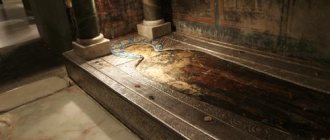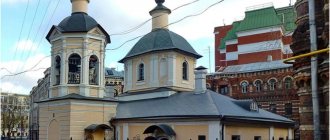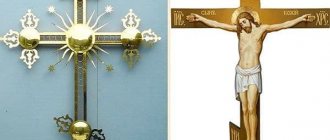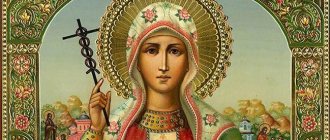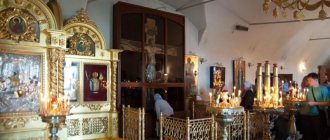The Life of Saint Nina and the Finding of the Cross
The saint was born at the end of the 3rd century into a pious and noble family. Her father Zabulon was in the military service of the emperor. At the age of 12, she and her parents went to Jerusalem, where, with the blessing of the bishop, her father became a hermit in the desert, and her mother, Susanna, became a deaconess. The girl was handed over to the pious elder Nianfora to be raised.
Learning from her mentor more and more details about the earthly life of the Lord, the saint became interested in the history of the Chiton - the robe of Christ, in which He was crucified and for which the soldiers cast lots. Nina learned that, according to legend, Chiton is located in Iveria (the ancient name of Georgia) and began to pray to the Mother of God to find him. This is what the widespread version of the life of St. Nina says, and this is what many Christians believe. According to another version, Heaton is located in the city of Trier.
Chiton of Christ in Trier
The Mother of God appeared to the girl in a dream. She handed Saint Nina a cross woven from a grapevine and said: “Go to Iberia and preach the Gospel. This cross will be your shield from all visible and invisible enemies.” When the saint woke up, the same cross lay next to her.
Relics of St. Nina in the Bodbe Monastery (Georgia)
And so it happened. Before this, pagan Iveria, through the labors of Saint Nina, accepted Christianity. The saint spent 35 years of her life preaching the Gospel in this country, and for these works the Church calls her Equal-to-the-Apostles Nina, the enlightener of Georgia. The saint found the tunic of Jesus Christ, and on this site - in the city of Mtskheta - a wooden temple was built, and later - a stone cathedral in honor of the 12 apostles.
Georgian Cross or St. Nino's Cross
Surely many of you, even those who have not yet visited Georgia, have come across the image of a cross with the crossbars lowered down - the canonical Georgian Cross (ჯვარი ვაზისა).
Stone Cross of St. Nino on the temple in Svetitskhoveli. Mtskheta
This is exactly how the cross of the Holy Equal-to-the-Apostles Enlightener of Georgia Nino is depicted. You can read in detail about the life and feat of Saint Nino here, but within the framework of this note we will only tell you about the miracle of finding the Cross and the history of this main shrine of the Georgian Orthodox Church.
In her youth, the saint was educated by the pious old woman Nianfora. From her, Nino learned that, according to legend, the Chiton of the Savior is located in Iveria (the ancient name of Georgia) and began to pray to the Mother of God to find it.
The Mother of God appeared to the girl in a dream. She handed Saint Nino a cross woven from a vine and said: “Go to Iberia and preach the Gospel. This cross will be your shield from all visible and invisible enemies.” When the saint woke up, the same cross lay next to her. It should be noted that Iberia was considered the destiny of the Mother of God; it was this country for preaching the Gospel that fell to her by lot with the holy apostles. When the Mother of God was ready to set off, an angel of God appeared to her and commanded her to stay in Jerusalem, promising that her lot would be fulfilled in due time.
And so it happened. Before this, pagan Iveria, through the works of Saint Nino, accepted Christianity. The saint spent 35 years of her life preaching the Gospel in this country, and for these works the Church calls her Equal-to-the-Apostles Nina, the enlightener of Georgia. The saint found the tunic of Jesus Christ, and on this place - in the city of Mtskheta - a wooden temple was built, and later - a stone cathedral in honor of the 12 apostles, which is located in Mtskheta and is called Svetitskhoveli.
The saint died in 340. The enlightener of Georgia never parted with her cross and bequeathed it to King Mirian, who was baptized thanks to Saint Nino. In Mtskheta, the ancient capital of Georgia, the cross was located until 458.
Then wars and persecution began in the country. The cross of St. Nino was kept by the Armenian governor for 175 years, in the Vanadad monastery for more than 450 years, in Kars for 164 years. King David found it in the city of Ani in 1125 and moved it to Mtskheta. From there he was transferred to the Church of the Holy Trinity on Mount Kazbegi. In 1746, by order of King Teimuraz II, in order to avoid desecration, the cross was hidden in the Ananuri fortress. From there, in 1749, Metropolitan Roman of Tiflis secretly sent the cross to the Georgian prince Bakar, who lived in Moscow. In 1801, his grandson, Georgy Alexandrovich, presented the cross to Emperor Alexander I.
The Russian emperor restored historical justice - the cross of St. Nino, as a property of the Georgian church, was sent with honors to the Zion Cathedral in Tbilisi. “...Knowing how precious this shrine is for the Georgian people and wishing by returning it to give new proof of my care for it, I sent this cross there to be placed in the Tiflis main Cathedral...” wrote Emperor Alexander I to Prince George Alexandrovich in February 1802.
Since 1802, the cross has been in Sioni, the cathedral of Tbilisi. The shrine was placed in a silver ark, on the lid of which scenes from the life of St. Nino are depicted, near the northern gate of the altar.
Sioni Cathedral in Tbilisi
Are you going to Georgia? Write to [email protected] - we will create the optimal travel route for you. Come and we will try to make your vacation unforgettable! You can get a free consultation by calling +995 555 566 540 *WhatsApp *Viber
Source: FOMA
The history of the cross after the death of St. Nina
The saint died in 340. The enlightener of Georgia never parted with her cross and bequeathed it to King Mirian, who was baptized thanks to Saint Nina. In Mtskheta, the former capital of Georgia, the cross was located until 458.
Then wars and persecution began in the country. The cross of St. Nina was kept by the Armenian governor for 175 years, in the Vanadad monastery for more than 450 years, in Kars for 164 years. King David found it in the city of Ani in 1125 and moved it to Mtskheta. From there he was transferred to the Church of the Holy Trinity on Mount Kazbek. In 1746, by order of King Teimuraz II, in order to avoid desecration, the cross was hidden in the Ananur fortress. From there, in 1749, Metropolitan Roman of Tiflis secretly sent the cross to Prince Bakar. In 1801, his grandson, Georgy Alexandrovich, presented the cross to Emperor Alexander I.
The Russian emperor restored historical justice - the cross of St. Nina, as a property of the Georgian church, was sent with honors to the Zion Cathedral in Tbilisi. “...Knowing how precious this shrine is for the Georgian people and wishing by returning it to give new proof of my care for it, I sent this cross there to be placed in the Tiflis main Cathedral...” wrote Emperor Alexander I to Prince George Alexandrovich in February 1802.
Orthodox Life
This is a cross made of grapevine, which, according to legend, the Most Holy Theotokos presented to her chosen one, appearing to her in a dream.
She said: “Go to Iberia (as Georgia was called in ancient times) and preach the Gospel. This cross will be your shield from all visible and invisible enemies.” When the saint woke up, next to her lay the same cross that had been with her constantly since then. Due to the fact that the cross was made of grapevine, the ends of its crossbar are lowered down and intertwined with the hair of St. Nina at the junction. This is what made him recognizable. She performed miracles with it, in particular healing the sick with it.
Saint Nina never parted with her vine cross and bequeathed it to King Mirian.
After the death of St. Nina in 340, wars and persecution began in the country. According to Georgian sources, the cross ended up with St. Shushanik. Feeling the approach of death, she handed him over to her confessor Andrei. In order to save the shrine from desecration in troubled times, he took it and moved it to the Taron region in Armenia.
The cross of St. Equal-to-the-Apostles Nina was kept by the Armenian governor for 175 years, in the Vanadad monastery for more than 450 years, in Kars for 164 years. According to some information, King David found it in the city of Ani in 1125 and moved it to Mtskheta. According to other sources, in 1239, the Georgian queen Rusudan turned to the Mongol commander Charmagan, who had captured the city of Ani, where the cross of St. Nina was located at that time, and asked to return it to Georgia. Charmagan granted the queen's request, and the cross returned to Svetitskhoveli.
In 1746, by order of King Teimuraz II, in order to avoid desecration, the cross was hidden in the Ananuri fortress. From there, in 1749, Metropolitan Roman of Tiflis secretly sent the Georgian cross to Prince Bakar. In 1801, his grandson, Georgy Alexandrovich, presented the cross to Emperor Alexander I. Then the Russian emperor restored historical justice - the cross of St. Equal-to-the-Apostles Nina, as a property of the Georgian Church, was sent with honors to the Zion Cathedral in Tbilisi. This event took place in 1801.
The Holy Cross, accompanied by clergy and guards along the entire route from Russia to Tiflis, was venerated with solemn services in front of a huge crowd of people and a military parade. The shrine was greeted by representatives of the clergy of all religious denominations of the city.
And so to this day, with short interruptions, the cross of St. Nina is in the Zion Cathedral.
There it is located next to the altar in a special ark, decorated with silver patterns. Around the cross you can see medallions; they are also made of silver and tell the story of the life and miracles of St. Nina. This was ordered by King Vakhtang III. The folding depicts six fragments from her life: the appearance of the Blessed Virgin Mary before St. Nina in Zion; handing over the vine cross to the Blessed Virgin Mary to St. Nina; dream of St. Nina on the shore of the lake and handing over to her a parchment with 10 chapters of St. Gospel by heavenly messenger; lightning strikes the idol of Armaz through the prayer of St. Nina; healing of the prince with the cross.
You can approach the cross and venerate yourself. It is brought out for worship on January 27 and June 1.
Orthodox pilgrims come to venerate the cross of St. Nina not only from all regions of Georgia, but also from Russia, Ukraine and other countries. They believe that, as once during the life of St. Nina, her cross will sanctify their lives and give them health and happiness.
Remembering the cross of St. Nina, it would not be amiss to mention the Bodbe Monastery, where her relics rest.
According to legend, there used to be a Church of St. Nina on the territory of the monastery, which was built here by King Mirian after the death of the enlightener. This church was rebuilt many times by Georgian monarchs. Many Kakheti kings were crowned kings there.
In the second half of the 18th century, the famous spiritual figure John of Bodbe founded a numerous monastery.
The grave of St. Nina is located inside the monastery. King Mirian wanted to bring her remains to Svetitskhoveli, but 200 people were unable to move her coffin. The king saw the will of God in this and buried her in Bodbe, and bequeathed to his wife, Queen Nana: “After my death, divide the royal treasury into two parts and donate one half to decorate the grave of St. Nina."
Gradually a monastery grew up around the temple. The Kakhetian kings were crowned in the church at the monastery.
In the 19th century, the Russian exarch Theophylact (Grusanov) decided to open the grave of St. Nina. John of Bodbe warned him not to do this, but could not convince him. The next day the exarch was found dead in his bedroom.
At the end of the 19th century, Emperor Alexander III visited the monastery and ordered the opening of a nunnery here. At this time, 300 nuns were saved in the monastery.
The last abbess of the monastery, Nino Vachnadze, was expelled by the communists after the Sovietization of Georgia, and a hospital was opened in the building. The supporters of the “new order” had a desire to remove the cross from the dome, but nothing came of it. The first enthusiast fell off the conical roof and crashed, others were scared and did not tempt fate.
In the first years of Soviet power, the monastery was not touched, but in 1924 it was closed by government decree. A hospital was located in its place. Monastic life in Bodbe resumed only in 1991.
One local resident, having lost the fear of God, cut up the face of the Iveron Icon of the Mother of God. And soon he died unexpectedly. Nevertheless, this incident did not frighten other desperate people who dared to use this icon in the hospital as a table in the X-ray room. One woman doctor’s grandson was ill. The Mother of God appeared to her in a dream and ordered her to return Her icon to the Bodbe Monastery. The doctor fulfilled the request of the Mother of God. After this, the grandson was healed.
Monastic life in Bodbe resumed only in 1991.
Nowadays the magazine “Bodbe Belfry” is published here, in which another legend associated with the name of St. Nina was recently published.
“In the village of Bodbe, at the door of the Church of All Saints, there lies a large boulder, which people call the Stone Woman. During the sermon of St. Nina lived in Bodbe with a family nicknamed Barnabaneby. They had seven sons and a 15-year-old daughter. It was she who came to the preacher and asked her for baptism. The Virgin from Cappadocia told her about the basics of the Christian faith and baptized her with the name Nino. From that time on, the girl accompanied her godmother everywhere.
Nino Jr.'s family began to worry about suitors. Her parents insisted that she choose the most worthy one. Tired of this, Nino ran away from home and found shelter with a helpless widow. She began to pray to the Mother of God that it would be better for her to turn to stone than to get married. Her prayer was heard, and the girl turned into stone. On the site of the widow's house, people built a church, and at the entrance they placed the Stone Woman.
In the courtyard of the monastery there is a healing spring, which appeared here through the prayers of Nino.
In the first years of Soviet power, the monastery was not touched, but in 1924 it was closed by government decree. A hospital was located in its place. Monastic life in Bodbe resumed only in 1991.
In ungodly times, water from the source began to be used for the hospital kitchen, so it disappeared.
One day, believing sisters came here from Russia, and they found a spring at the foot of the slope. A small church of St. Zebulon and St. Susanna was later built on this site. There is a bathhouse in the lower part of the church. You can dive only in special tunics. Washing there by grace is equated to Holy Communion.
Mariam Sarajishvili
What does the cross of St. Nina look like?
The cross of Equal-to-the-Apostles Nina is easy to recognize: the ends of its horizontal crossbar are lowered down and in appearance it resembles an abbot's or bishop's staff. It is made entirely of vines and at the junction of the crossbars is intertwined with the hair of St. Nina. In iconography, the Equal-to-the-Apostles enlightener of Georgia is usually depicted with a characteristic cross and the Gospel in her hands.
Cross of St. Nina, modern view. Photo by Gábor Tikos_Flickr_CC BY-SA 2.0
Great Shrines of Georgia
Candide and Calvin wanted to take possession of this shrine and, upon their return from Palestine, they made exactly the same reliquary, similar to the one in which Chiton was located. At night they changed the reliquaries.
The Byzantine emperor treated the shrine with great respect and placed it in the monastery of the Blachernae Most Holy Theotokos, specially built for this purpose. But later Heaton was considered lost. The first information about it appeared in the 5th century. Until the 14th century, all historical sources confirm that Chiton is located in the capital of the Byzantine Empire, Constantinople.
After the fall of the Byzantine Empire, one Archbishop brought this shrine to Mingrelia to save it from the Muslims. The middle part of the belt of the Chiton of the Mother of God, on which Her image was embroidered by the hands of the Most Holy Theotokos herself, also came to Georgia. According to one of the historical sources, he was taken from Byzantium by Bagrat III’s wife Helen and placed in the Bedia Monastery.
Then the Chiton of the Mother of God appeared in the Dadiani palace, from where it was transferred to the Khobi Monastery. In 1936, when the shrines removed from churches and monasteries were transferred to museums, the Chiton of the Mother of God returned to the Dadiani Palace.
In the Christian world, there are three miraculous images of Christ: on Ubrus, the Shroud of Turin and the image of the Savior on the Chiton of the Mother of God in Zugdidi.
There are many legends about the miraculous power of the Chiton of the Mother of God. The first miracle was recorded in 632. It is known that the Chiton of the Mother of God twice saved the capital of Byzantium, Constantinople, from the invasion of the Saracens and Egyptians.
One day, Constantinople was surrounded for six days by an army of Saracens led by the famous leader Moab. Patriarch Photius brought out the Chiton and touched it to the sea, and the stormy waves swallowed up the enemy ships...
One miracle was recorded in Georgia in 1891. Robbers stole the Heaton from the Khobi Monastery. Historical sources say that the entire population of Mingrelia and Khobi took part in his search, but to no avail. However, three days later, Heaton was found miraculously - in the forest, in a place glowing with an extraordinary light.
In the 17th century, Patriarch of Antioch Macarius wrote to the Patriarchate of Jerusalem: “I am happy that I am in Mingrelia in the Tsalendzhik Monastery and the Chiton of the Mother of God lies in front of me and I look at it.” Macarius of Antioch placed expensive fabric on the Chiton, cut out a similar one after it and consecrated it. A copy of the Chiton remains in Constantinople today as a shrine.
The image of the Chiton of the Most Holy Theotokos became an integral part of the coat of arms of Tsarevich Nugzar Bagrationi-Gruzinsky, Head of the Royal House of modern Georgia.
